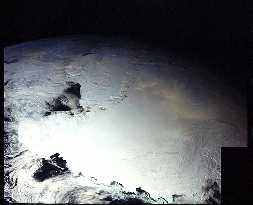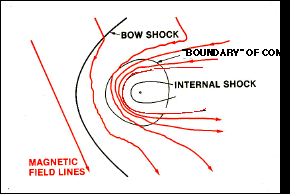This is an image of Pluto with its moon Charon.
Click on image for full size
Image courtesy of NASA/JPL. This image is in the public domain.
Pluto & Charon, a double planet
Of all the planets and moons in the solar system, Pluto and Charon are the two which are the most alike. They are almost the same size, and they are very close together.
Pluto and Charon are so close that they may even share an atmosphere. Air may be drawn from Pluto by the gravity of Charon to reform on Charon.
The only other planet and moon in the solar system which could be a double planet are the Earth and the Moon. The origin of such a double planet is hard to explain. The best explanation may be that some large object struck Pluto (and the Earth) and tore out a blob which became Charon (and the Moon) from the crust of the planet.
In the case of the Moon, the Moon seems to be made of rock which is very much like the Earth's crust and not like the Earth's iron interior. Likewise Charon may be made of more icy material which looks like Pluto's surface, rather than the more rocky interior of Pluto.
You might also be interested in:

It may seem hard to believe that Pluto could have an atmosphere because it is so cold, but it does. Because there are times when Pluto is closer to the sun than is Neptune (making it the 8th planet for
...more
Pluto has // Call the moon count function defined in the document head print_moon_count('pluto'); moons. One of the moons is very big. The big moon is name Charon. The other two moons are small. They don't
...more
Charon is a moon of Pluto. Pluto has // Call the moon count function defined in the document head print_moon_count('pluto'); moons. Charon is much bigger than Pluto's other moons. James Christy discovered
...more
Of all the planets and moons in the solar system, Pluto and Charon are the two which are the most alike. They are almost the same size, and they are very close together. Pluto and Charon are so close
...more
Pluto is so far away, and has never been explored. Questions to answer about Pluto include the following: What are the geologic features of the surface? (pictures of the surface) If there are bare spots,
...more
No one knows whether or not Pluto has a magnetosphere. Scientists were very surprised to find that Jupiter's icy moon Ganymede had a magnetosphere because it is hard to explain how an icy body can develop
...more
Pluto is a frigid ball of ice and rock that orbits far from the Sun on the frozen fringes of our Solar System. Considered a planet, though a rather odd one, from its discovery in 1930 until 2006, it was
...more












